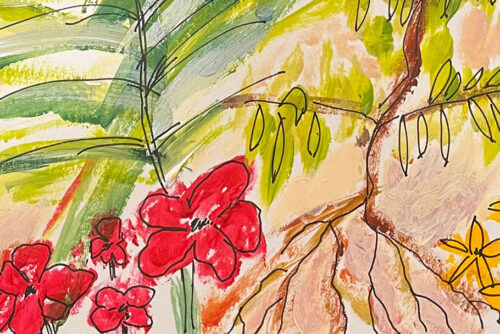“[Josephine Baker] embodies the frenzy of jazz, the hard rhythms of modern sculpture, [and] the tormented vagaries of contemporary melodies […].” 1 As this 1930 article suggests, Josephine Baker, the young American dancer who captured the hearts of the Parisian public, captured the spirit and color of the jazz age as well. Dubbed “the Black Venus” (la Vénus noire), “the black star,” and “the empress of jazz,” Baker experienced an extraordinary success in Paris in the 1920s. Her performance with La Revue Nègre at the Théâtre des Champs-Elysées in Paris in 1925 launched a vogue for the black bottom and Charleston across Europe and advanced the craze for jazz that had already overtaken the capital.
In much of the reception of the period, the Vénus noire came to be seen as an exemplary figure of urban modernity. The cross-play of the arts found force in the figure of Baker, who was considered the living embodiment of modernist art, from primitivism to German expressionism to cubism. The premiere of La Revue Nègre gave rise to a number of visual metaphors. For dance critic André Levinson, Baker’s plastic poses had the potency of “the finest examples of Negro sculpture”; for a critic of Le Soir, La Revue Nègre constituted the “quintessence of the modernism of the music hall”; one spectator commented simply, “It’s cubist.” 2 In the words of contemporary critics Karen Dalton and Henry Louis Gates Jr., “Josephine Baker was primitivist-modernism on two legs, the cubists’ art nègre in naked, human form.” 3 The frenetic pace of her dance and the liberty of her movements seemed to provide an aesthetic response to the kaleidoscopic fervor of the Roaring Twenties. In Baker, one saw a mirror of modernity, a reflection of its palpitating rhythm, its perpetual movement, its ephemeral and fleeting nature. Paul Colin’s art deco designs of Baker, which appeared in a portfolio of 45 hand-colored lithographs entitled Le Tumulte noir (1927), capture the energy and rhythm of Baker’s movements [Figure 1]. The stark lines, bold colors, and exaggerated angles of the drawings render Baker a vivid articulation of the throbbing metropolis. For Count Harry Kessler, Josephine Baker and La Revue Nègre were both “ultramodern” and “ultraprimitive.” On a performance of La Revue Nègre at the Nelson theater in Berlin in 1926, Kessler wrote, “They are a cross between primeval forests and skyscrapers; likewise their music, jazz, in its color and rhythms. Ultramodern and ultraprimitive.” 4

Primitivist modernism in motion, Baker, considered by one critic “a saxophone in movement,” embodied for many the spirit of jazz. 5 Jazz had reached Paris as early as 1917, with the arrival of African American regiments in France, whose bands, such as Harlem’s Hellfighters and Seventy Black Devils, performed throughout the country. 6 The most well-known band was Lieutenant James Reese Europe’s Hellfighters, drawn from the highly decorated 369th Infantry Regiment of New York. In the early months of 1918, the Hellfighters went on a grand tour of France, visiting over 25 provincial French cities in a period of six weeks (Shack 2001, p. 19). These “goodwill ambassadors” were responsible for raising the morale of Allied troops on the front and in country hospitals (Blake 1999, p. 62). The Hellfighters, who drew the attention both of the armed forces and the civilian population during the war, represented the United States at a number of ceremonies marking the war’s end. While many American G.I.’s returned home after the war, jazz left an indelible mark on the French capital. The most famous early jazz bands were drummer Louis Mitchell’s Jazz Kings, a group of seven jazz musicians which played at the Casino de Paris and various cabarets across Paris, and violinist Will Marion Cook’s Southern Syncopated Orchestra, a 41-piece orchestra which gave a series of concerts at the Théâtre des Champs-Elysées in 1921 in the wake of a European tour. 7
- Le Cri de Paris, 10 oct. 1930 (in Abatino 1931, p. 40).[↑]
- André Levinson, “The Negro Dance: Under European Eyes,” in André Levinson on Dance: Writings from Paris in the Twenties, ed. by Joan Acocella and Lynn Garafola (Hanover, NH, and London: University Press of New England, 1991), p. 74; Phillipe d’Olon, “Au Champs-Elysées Music Hall: Damia, Gabaroche, La Revue Nègre,” Le Soir, 1er nov. 1925; Michel Georges-Michel, “Soirée nègre,” Comœdia, 28 sept. 1925.[↑]
- Karen C.C. Dalton and Henry Louis Gates Jr., “Josephine Baker and Paul Colin: African American Dance Seen Through Parisian Eyes,” Critical Inquiry, 24 (Summer 1998), p. 933. For a discussion of Baker as a figure of primitivist modernism, see Sieglinde Lemke, Primitivist Modernism: Black Culture and the Origins of Transatlantic Modernism (Oxford: Oxford University Press: 1998), pp. 95-116.[↑]
- Harry Graf Kessler, Tagebücher 1918-1937 (Frankfurt am Main: Insel Verlag, 1961), entry for February 26, 1926, p. 482. Quoted in translation in Peter Jelavich, Berlin Cabaret (Cambridge, MA, and London: Harvard University Press, 1993), p. 171.[↑]
- Pierre de Régnier, “Aux Champs-Elysées: La Revue Nègre,” Candide, 12 nov. 1925.[↑]
- Louis Mitchell’s Seven Spades, which performed in Paris in November 1917 and evolved into the Jazz Kings, is thought to be the first jazz band to make an appearance in Paris. For discussions of early jazz in the French capital, see Jody Blake, Le Tumulte noir: Modernist Art and Popular Entertainment in Jazz-Age Paris, 1900-1930 (University Park, PA: Pennsylvania State University Press, 1999), pp. 62-66; Bernard Gendron, Between Montmartre and the Mudd Club: Popular Music and the Avant-Garde (Chicago and London: University of Chicago Press, 2002), pp. 108-110; and William A. Shack, Harlem in Montmartre: A Paris Jazz Story Between the Great Wars (Berkeley, Los Angeles, and London: University of California Press, 2001), pp. 11-25.[↑]
- Jody Blake, “‘Jazz-band Dada’: L’afro-américanisme dans le Paris de l’entre-deux-guerres,” Revue de L’Art, 118: 4 (1997), p. 70.[↑]



